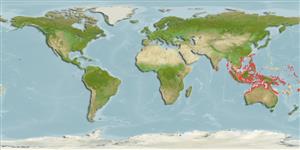Teleostei (teleosts) >
Ovalentaria/misc (Various families in series Ovalentaria) >
Pseudochromidae (Dottybacks) > Pseudochrominae
Etymology: Pseudochromis: Greek, pseudes = false + Greek, chromis = a fish, perhaps a perch (Ref. 45335); fuscus: Name from Latin meaning dark or dusky, referring to the dark colour form of the species.
More on authors: Müller & Troschel.
Environment: milieu / climate zone / depth range / distribution range
Ecology
Marine; reef-associated; depth range 2 - 30 m (Ref. 9710), usually 3 - 25 m (Ref. 27115). Tropical; 26°N - 24°S
Indo-Pacific: Sri Lanka east to Vanuatu; north to at least Hong Kong and the Ryukyu Islands; south to the central coast of Western Australia and the southern Great Barrier Reef.
Size / Weight / Age
Maturity: Lm ? range ? - ? cm
Max length : 10.0 cm TL male/unsexed; (Ref. 48635)
Found among corals of subtidal lagoon and seaward reefs (Ref. 9710). Also found in crevices and ledges. Usually found in association with branching corals (e.g. Acropora and Pocillopora). Sometimes enters the aquarium fish trade (Ref. 37748). Has been reared in captivity (Ref. 35413). Solitary (Ref 90102).
Life cycle and mating behavior
Maturity | Reproduction | Spawning | Eggs | Fecundity | Larvae
Randall, J.E., G.R. Allen and R.C. Steene, 1990. Fishes of the Great Barrier Reef and Coral Sea. University of Hawaii Press, Honolulu, Hawaii. 506 p. (Ref. 2334)
IUCN Red List Status (Ref. 130435: Version 2024-2)
Threat to humans
Harmless
Human uses
Fisheries: commercial; aquarium: commercial
Tools
Special reports
Download XML
Internet sources
Estimates based on models
Preferred temperature (Ref.
123201): 25.3 - 29, mean 28 °C (based on 704 cells).
Phylogenetic diversity index (Ref.
82804): PD
50 = 0.5000 [Uniqueness, from 0.5 = low to 2.0 = high].
Bayesian length-weight: a=0.00501 (0.00193 - 0.01299), b=3.10 (2.88 - 3.32), in cm total length, based on LWR estimates for this (Sub)family-body shape (Ref.
93245).
Trophic level (Ref.
69278): 3.5 ±0.5 se; based on size and trophs of closest relatives
Generation time: 1.1 ( na - na) years. Estimated as median ln(3)/K based on 1
growth studies.
Resilience (Ref.
120179): High, minimum population doubling time less than 15 months (Preliminary K or Fecundity.).
Fishing Vulnerability (Ref.
59153): Low vulnerability (14 of 100).
Nutrients (Ref.
124155): Calcium = 152 [79, 239] mg/100g; Iron = 0.846 [0.510, 1.398] mg/100g; Protein = 18.4 [17.3, 19.4] %; Omega3 = 0.103 [0.060, 0.182] g/100g; Selenium = 28.2 [13.5, 58.7] μg/100g; VitaminA = 111 [36, 328] μg/100g; Zinc = 2.03 [1.35, 2.90] mg/100g (wet weight);
